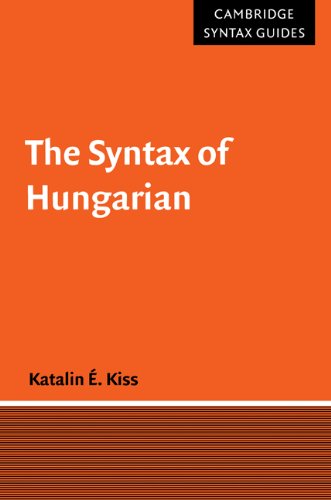

Most ebook files are in PDF format, so you can easily read them using various software such as Foxit Reader or directly on the Google Chrome browser.
Some ebook files are released by publishers in other formats such as .awz, .mobi, .epub, .fb2, etc. You may need to install specific software to read these formats on mobile/PC, such as Calibre.
Please read the tutorial at this link. https://ebooknice.com/page/post?id=faq
We offer FREE conversion to the popular formats you request; however, this may take some time. Therefore, right after payment, please email us, and we will try to provide the service as quickly as possible.
For some exceptional file formats or broken links (if any), please refrain from opening any disputes. Instead, email us first, and we will try to assist within a maximum of 6 hours.
EbookNice Team

Status:
Available4.5
23 reviews
ISBN-10 : 0511020651
ISBN-13 : 9780511020650
Author: Katalin E. Kiss
Clearly written and comprehensive in scope, this is an essential guide to syntax in the Hungarian language. It describes the key grammatical features of the language, focusing on the phenomena that have proved to be theoretically the most relevant and have attracted the most attention. The analysis of Hungarian in the generative framework since the late Seventies has helped to bring phenomena which are non-overt in the English language into the focus of syntactic research. As Kiss shows, its results have been built into the hypotheses that make up universal grammar. The textbook explores issues at the centre of theoretical debates including the syntax and semantics of focus, the analysis of quantifier scope, and negative concord. This useful guide will be welcomed by students and researchers working on syntax and those interested in Finno-Ugric languages.
1 Introduction
1.1 Genealogy, areal distribution
1.2 A general overview of the syntactic and morphosyntactic features of Hungarian
2 The topic–predicate articulation of the sentence
2.1 The topic function
2.2 The formal features of the topic constituent
2.3 The marking of the topic–predicate boundary
2.4 The topic projection
2.5 Apparent and real topicless sentences. The (in)definiteness effect
2.6 Sentence adverbials and the topic–predicate articulation
2.7 The contrastive topic
2.8 Summary
3 The minimal predicate
3.1 Argument order in the VP
3.2 The referentiality effect
3.3 The subject as an internal argument
3.4 The structure of the VP
3.4.1 Evidence from disjoint reference
3.4.2 Evidence from anaphora
3.4.3 Evidence from Weak Crossover
3.4.4 Weighing the evidence
3.5 Morphosyntactic projections
3.5.1 Modality, tense, mood
3.5.2 Object agreement and subject agreement
3.6 The verbal prefix
3.6.1 Its category and structural position
3.6.2 The AspP projection
3.6.3 The class of verb modifiers
3.7 The nominal predicate
3.8 Summary
4 Focussing
4.1 The focus function
4.2 The syntax of focus
4.2.1 Deriving the focus–verb adjacency
4.2.2 The FP projection
4.3 Inherent foci
4.4 Only-phrases
4.4.1 The syntax of only
4.4.2 The semantics of only
4.5 Wh-questions
4.5.1 Simple wh-questions
4.5.2 Multiple questions
4.6 Summary
5 Quantification
5.1 Distributive quantifiers at the head of the predicate
5.2 The DistP projection
5.3 The scope principle
5.3.1 Preverbal quantifiers
5.3.2 Postverbal unstressed quantifiers
5.3.3 Postverbal stressed quantifiers
5.3.4 Quantifiers in topic position
5.3.5 Noun phrase internal quantifiers
5.4 Quantifiers or adverbial modifiers?
5.5 Summary
6 Negation
6.1 Two NegP projections
6.2 The locus of negative pronouns licensed by nem
6.3 The status of sem
6.4 The universal and existential readings of negative pronouns
6.5 Long distance negative polarity
6.6 The negative existential verb
6.7 Summary
7 The noun phrase
7.1 The basic syntactic layers of the noun phrase
7.2 Evidence for the different noun phrase projections
7.3 The possessive construction
7.3.1 The facts
7.3.2 Relating the caseless and the dative possessor
7.3.3 Agreement and anti-agreement in the possessive construction
7.3.4 The non-specific possessive construction
7.4 Non-possessor arguments in the noun phrase
7.4.1 The subject and object of the verbal stem in event noun phrases
7.4.2 Oblique arguments and adjuncts
7.5 Summary
8 The postpositional phrase
8.1 Restricting the category of postpositions
8.2 The formal properties of postpositional phrases
8.2.1 Distribution
8.2.2 Agreement and anti-agreement phenomena
8.3 The structure of the postpositional phrase
8.4 PPs as verb modifiers
8.5 Case-marked pronouns or PPs?
8.6 Summary
9 Non-finite and semi-finite verb phrases
9.1 Introduction
9.2 Subject and object control constructions
9.2.1 Subject and object control verbs
9.2.2 The inner structure of the infinitive phrase
9.2.3 Long distance object agreement?
9.3 Infinitival complex predicates
9.3.1 The licensing of verbal complex formation
9.3.2 The straight verbal complex
9.3.3 The inverse verbal complex
9.4 Agreeing infinitives with a case-marked subject
9.4.1 Their formal properties
9.4.2 The distribution of the agreeing infinitive and the dative subject
9.4.3 The source of the dative case
9.5 Adverbial participle phrases
9.5.1 Adjunct adverbial participle phrases
9.5.2 Predicative adverbial participle phrases
9.6 Adjectival participle phrases
9.7 Summary
10 The subordinate clause
10.1 Introduction
10.2 That-clauses
10.2.1 The structure of clausal arguments
10.2.2 The position of the subordinate clause in the matrix sentence
10.2.3 Interrogative that-clauses
10.2.4 Adjunct that-clauses
10.3 Relative clauses
10.4 Adverbial clauses
10.5 Long operator movement
10.5.1 The types of operators subject to long movement
10.5.2 Constraints on long operator movement
10.5.3 The procedure of long operator movement
10.5.4 A base-generated construction
10.6 Parasitic gaps
10.7 Summary
the hungarian alphabet
the syntax and grammar of a language refer to the
hungarian syntax programming
hungarian syntax
a sentence in hungarian
Tags: The Syntax, Hungarian, Katalin Kiss, essential guide